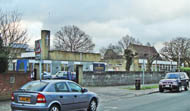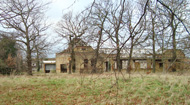Convalescent. Later, tuberculosis.
Made easily accessible by the railway, Swanley's fresh air climate was seen as being the ideal place to send sick Londoners.
The Kettlewell Convalescent Home was established for poor patients needing to recuperate after major surgery at St Bartholomew's Hospital, of which the then Prince of Wales (later King Edward VII) was President. The Home was officially opened on 13th July 1885 by the Prince, his wife Princess Alexandra and their three daughters. The cost of the building - £15,000 - had been donated by a Mr. C.T. Kettlewell.
The Home, in 15 acres of grounds, consisted of a long front block with the wards projecting from it, and a central projecting wing with two side wings at the back. The building could accommodate 45 male and 25 female patients. A chapel, donated by Ebenezer Homan, a governor and almoner of St Bartholomew's Hospital, was connected by a corridor to one end.
The ground floor of the front block contained the main entrance, the Medical Officer's room, the Matron's room, a committee room and five day rooms. On the first floor there were eight dormitories and Matron's bedroom. A small part of the central wing had two further storeys containing a dormitory for patients and two bedrooms for the nurses. The servants slept on the very top floor. The kitchen and dining room were in the central wing and the side wings contained bathrooms and WCs. At the north of the site there was a huge laundry which carried out work for both St Bartholomew's Hospital and the convalescent home.
During WW1 the Kettlewell Home was used as a military hospital for convalescent servicemen. It was affiliated to the First London (T.F.) General Hospital and had 70 beds.
In 1920 the Alexandra Hospital for Children with Hip Disease left Queen Square and relocated to the site. The new location afforded the Hospital more space, which made it more pleasant for the patients. The majority of patients were children suffering from tuberculosis of the hip, knee or spine, or from non-tuberculous conditions such as club foot, coxa plana and infective arthritis. Because many of the children stayed for several years, schooling was provided. Other activities included plays, parties and visits by organisations such as the Boy Scouts and Girl Guides.
In 1922 the Alexandra Hospital amalgamated with St Bartholomew's and the Committee of Management for the Home was renamed the Committee of the Alexandra Hospital and Kettlewell Home.
Over the years the Alexandra Hospital gradually improved the building. Electric lighting was installed, as well as new hot water and heating systems, an electric lift and an X-ray Department. An isolation block was built, as well as a Nurses' Home and a residence for the Medical Superintendent.
In June 1940 the Hospital was evacuated to Stockwood Park, near Luton in Bedfordshire, leased from Luton Borough Council. It had 75 beds.
During WW2 the Kettlewell site was again used as a military hospital.
In 1948 it joined the NHS as the Kettlewell Hospital under the control of the Sidcup and Swanley Hospital Management Committee, part of the South East Metropolitan Regional Hospital Board. It had 100 beds for patients with pulmonary tuberculosis. Most stayed on average for 131 days (157 days in 1949).
In 1952 the use of the Hospital changed from chronic to acute TB cases. Patients with more advanced disease stayed longer. In 1953 arrangements were made for patients to be surgically treated at Hill End Hospital, then returned to Queen Mary's Hospital, Sidcup.
In 1959 the Hospital was declared redundant and closed.
Present status (December 2008)
The Kettlewell Home site is now partly occupied by the St Bartholomew's Primary School in Sycamore drive and partly by the Asda car park. The nearby Roman Catholic church was built from the Home's chapel.

The convent, school and church as seen from the north.


The Roman Catholic Church of the Holy Apostles in Sycamore Drive, off Bartholomew Way.




(Author unstated) 1885 Masonic and General Tidings. The Freemason, 18th July, 358.
(Author unstated) 1917 List of the various hospitals treating military cases in the United Kingdom. London, H.M.S.0.
Burdett HC 1893 Hospitals and Asylums of the World, Vol IV. London, J & A Churchill, 302.
Sanderson E, Melville L 1910 King Edward VII, His Life and Reign; the Record of a Noble Career, Vol. 2. London, Gresham, 56.
http://rcnarchive.rcn.org.uk
http://takingstock.org.uk
www.aim.25.ac.uk
www.flickr.com
www.francisfrith.com
www.garyvaughanpostcards.co.uk
www.hharp.org
www.swanleytowncouncil.gov.uk
Return to home page